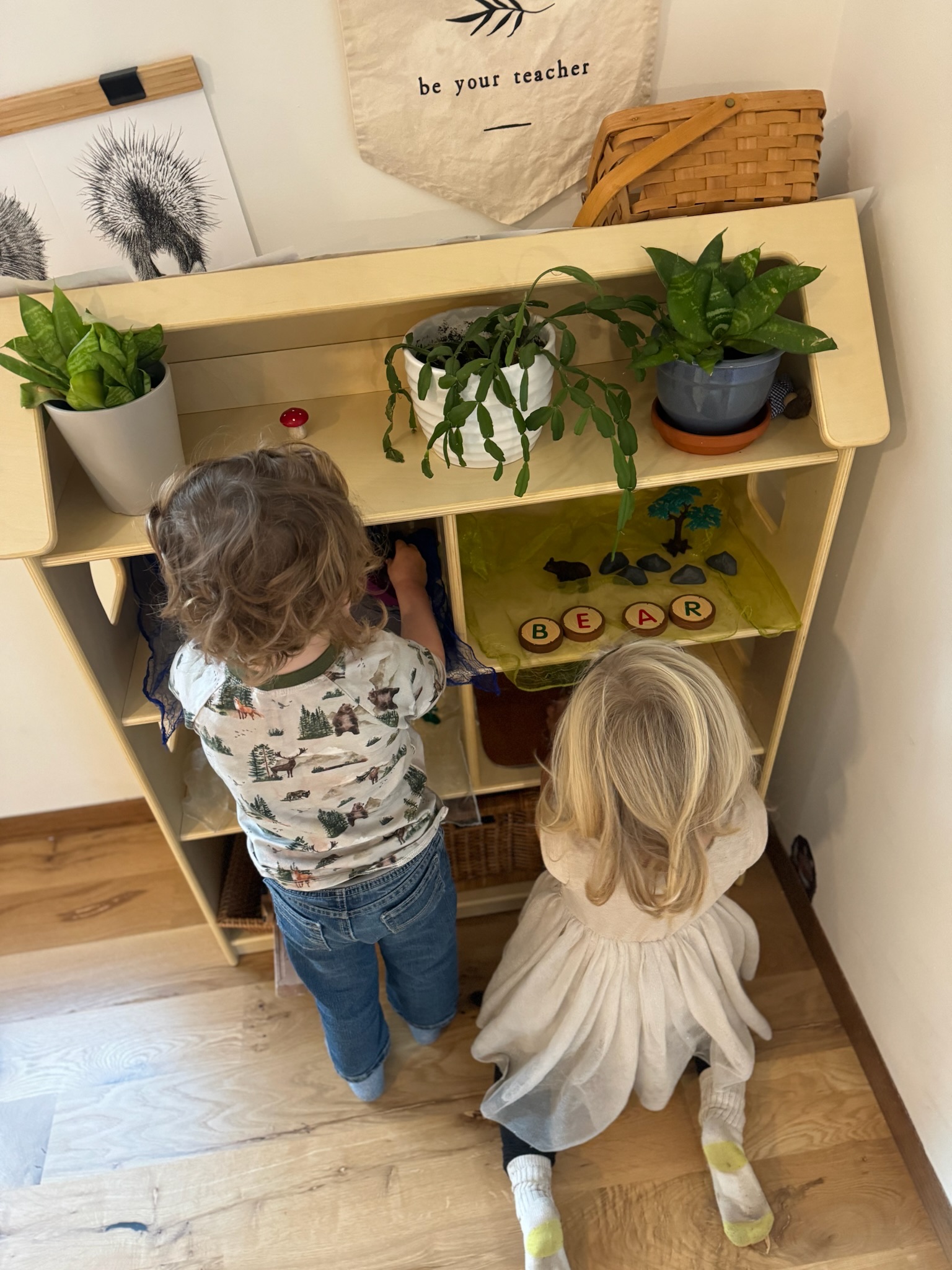Content of the Preschool Theme
One of the first play schemes that began to develop at our nature preschool this year was bear play. It was a simple game, typically involving the child who was the “bear” hiding from their friends, then roaring and running after them. This was fun, but also generated the idea that bears just chase and eat people. The wildlings were clearly very interested in bears, and with the plethora of children’s books available about bears, our teaching team decided this would be our next preschool theme to explore with them.

Tenants of our Emergent Curriculum
- A theme that is of the children’s interest is identified by coteachers and we discuss as a teaching team how this theme would be best presented. We discuss: what are the relevant topics related to this theme? Is the theme too broad? Too narrow? How long do we feel children will be engaged with this theme? What materials do we need to find and what library books do we need to reserve?
- Children have a chance to share what they already know about the theme, either in our documentation “big book” or in their journals. They have a chance to ask questions and let us know what they want to learn more about.
- We encourage the inquiry process through open-ended questions and exposure to abstract concepts related to the theme.
- Books and activities are planned to meet Early Childhood Indicators of Progress (MN state standards) and children’s developmental and intellectual needs.
For the bear theme, we identified topics such as hibernation, predator/prey, what bears eat, and what bears generally do (such as not often chasing people and eating them – haha!)
Activities for this Preschool Theme
- Documented in the big book: What do you know about bears?
- This gave a baseline to see what children actually knew about bears. Most children said something along the lines of, “They eat people,” which made sense with the game they had previously been playing
- Make a hibernating bear sculpture
- Using air dry clay, a cardstock photo of a sleeping bear, and loose parts, children were encouraged to create their own hibernating bear sculpture.
- Watercolor a bear
- Most printer ink will not smudge with watercolors! I cut white construction paper to fit in my printer for an easy open-ended but on-theme art activity.
- Journal: If you were a bear, what would you do?
- At this point in the theme, some children were still saying, “Eat people,” whereas, others were saying things like, “Sleep all winter long.” This is a great way to assess if children are picking up concepts when exploring a theme!
- Created “B” for bear with Handwriting Without Tears curves and lines.
- The children had a blast making other letters and shapes as well. During this type of activity, I encourage them to make the inspiration letter, but do not require them to do so.
- Used Growing Up Wild curriculum resource to color and cut out pictures of bear food. Then, we sing a song about what bears eat and put the pieces into our bags.
- Documented in big book: venn diagram to illustrate foods that bears eat, food that we eat, and foods that overlap.
- Journal: what have you learned about bears?
- Had “Fuzzy the Bear” visit our classroom.
- My grandpa hunted a bear many years ago, and I remembered it hanging in my grandparents’ and my childhood home over the years. I asked to borrow it from my grandpa, and the children enjoyed being able to feel the bear fur and teeth. I would often lay it on our circle time rug while I read a story, and they would pet the fur while they listened.

Favorite Books
- The Three Bears by Paul Galdone
- Bears in the Bath by Shirley Parenteau
- Bear’s Scare by Jacob Grant
- A Bear’s Year by Kathy Duval and Gerry Turley
- Three Snow Bears by Jan Brett
- A Story for Small Bear by Alice B. McGinty
- Bear’s Big Dreaming by Michel Rosen
- Bears in Beds by Shirley Parenteau
- Books Aren’t for Bears by Mark Barry
- The Invisible Bear by Cecile Metzger
What was Learned by the Students?
Cognitive Skills:
- Literacy: Vocabulary (hibernation, predator, etc.)
- Math: Children were introduced to the idea of a venn diagram
- Science: Children learned about what bears eat, what they do, and how they hibernate.
Motor Skills:
- Gross motor: Children develop their gross motor skills each day through outdoor play in nature, but they developed their strength and endurance through playing the bear game
- Fine motor: Children developed fine motor skills through painting and drawing in their journals.
Social-Emotional Skills:
- Children learn social skills with peers through play and working together in the documentation book. Many of the stories we read also gave the opportunity to discuss the characters’ feelings.

Memorable Moments and Closing Thoughts
This theme was so much fun, particularly because there is so much great children’s literature on bears! It was great to have a good mix between nonfiction and fiction books to read. It was interesting to see the children’s play around bears develop over time during this preschool theme, with many of them starting to play “hibernation” and finding “bear dens” in the forest to sleep in. Through this theme, the children developed a deep interest in animal homes, which led us into our next theme: animal habitats!







